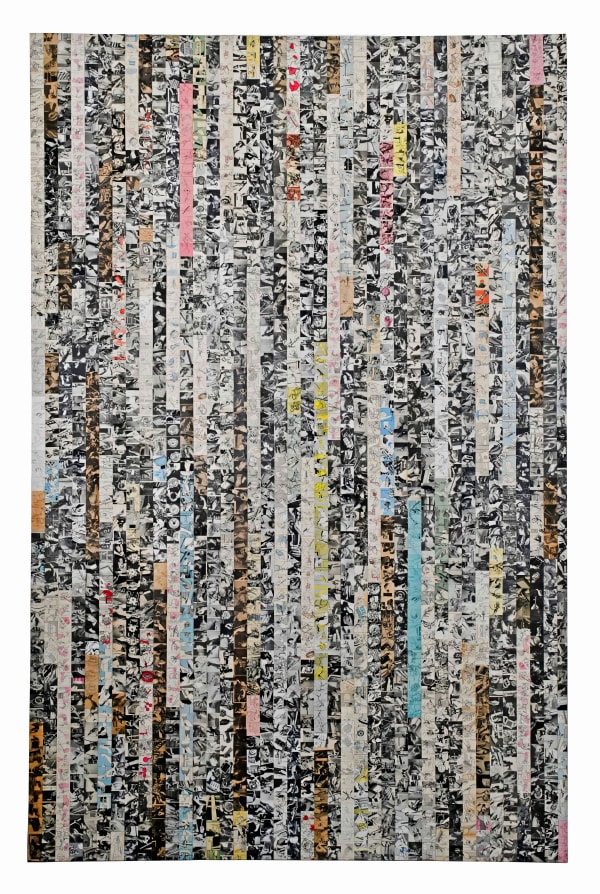Solo Show: Juan David Laserna | Museography by Liliana Andrade
Past exhibition
Overview
It's possible that "collage" is an inadequate term to describe the legacies of the multidimensional 20th century, which was marked by its ability to create horrific conflicts and reproduce them on a massive scale. This concept represents the unsettling reality of the era's achievements and their consequences.An image inserted in a frame populated with other images, communicating with each other to produce a new relationship, collage is like a reproductive act, in which a new subject emerges from the encounter of previous sources that come together sexually until they separate and disappear, leaving the genetic mark of their origin as architecture.- Juan Davil Laserna MontoyaMuseography: Liliana Andrade
It's possible that "collage" is an inadequate term to describe the legacies of the multidimensional 20th century, which was marked by its ability to create horrific conflicts and reproduce them on a massive scale. This concept represents the unsettling reality of the era's achievements and their consequences.
An image inserted in a frame populated with other images, communicating with each other to produce a new relationship, collage is like a reproductive act, in which a new subject emerges from the encounter of previous sources that come together sexually until they separate and disappear, leaving the genetic mark of their origin as architecture.
We commonly understand collage as something that happens on a page, but in reality, it is more like an adjective used to qualify operations that range from cinematographic montage to the urban pastiche of the Latin American city.
This exhibition, intentionally left orphaned of a title, attempts, at least in its premise, to function as a collage in space, bringing together and communicating divergent collections of images, replicating through a museographic act what scissors, cutters, and glue do with paper cutouts.
The pieces are displayed on panels inspired by the albums and atlases of Western visual culture. They are collections of images with multiple personalities, some explicitly or tacitly connected as convenient, others revealing their printed sources in their pictorial behavior. Memories of publications from past visual regimes also intersect with popular culture, politics, or military theater.
Very small cutouts of human bodies appear as raw materials of monochromatic grids, and large-format mosaics made with cutouts from supermarket catalogs resemble shelves of serial products, processed and repeated to hide the fields of cultivation or the animals that become filleted meat.
All these subjects speak to each other through museography, which connects everything in a device that allows for some short circuits; a small painting serves as a color scale, paper mache prehistoric heads watch over the panels, and a traditional collage serves as a semicolon in the next floor of the gallery.
The exhibition proposes an association of things without the central guide of a text that offers coordinates, leaving the work to the visual cultures and traditions that, as more or less knowledgeable spectators, we know how to navigate, and in which we can definitely recognize the prosaic, the solemn, the useless, the powerful, the ridiculous. Our tradition does half the work, and the encounters, subtle cutouts, and superimpositions of images promote the rest of the reading.
- Juan David Laserna
Works
-
 Juan David Laserna, Agriculturística, 2023
Juan David Laserna, Agriculturística, 2023 -
 Juan David Laserna, Animal Print, 2023
Juan David Laserna, Animal Print, 2023 -
 Juan David Laserna, El lácteo pecho de los hombres, 2023
Juan David Laserna, El lácteo pecho de los hombres, 2023 -
 Juan David Laserna, Lo mejor que le pasó a la mujer desde que perdió al hombre, 2023
Juan David Laserna, Lo mejor que le pasó a la mujer desde que perdió al hombre, 2023 -
 Juan David Laserna, Matrimonios entre todx y todxs, 2023
Juan David Laserna, Matrimonios entre todx y todxs, 2023 -
 Juan David Laserna, Mentón cuadrado, 2023
Juan David Laserna, Mentón cuadrado, 2023 -
 Juan David Laserna, Faber Popularis, 2023
Juan David Laserna, Faber Popularis, 2023
Installation Views









